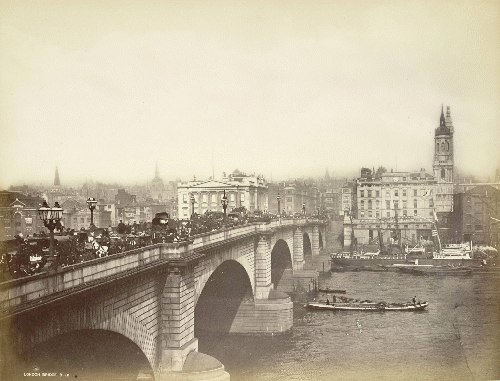/>New London Bridge by Cornell Univ. Library
Who among us doesn't remember the old nursery rhyme/singing game "London Bridge is Falling Down?" It has around for a long, long time -- likely since the mid-17th century, when the then nearly 600-year-old bridge began showing signs of deterioration. Originally built way back in 1176, the medieval London Bridge, severely damaged in the fires of 1633 and 1666, was widened and upgraded in the early 1760s, and finally replaced by a new structure in 1831. This engineering marvel -- called "New London Bridge" -- spanned the Thames until 1972, when it was torn down and moved to Lake Havasu City, Arizona. Doing the math, the medieval London Bridge was in use for 655 years; "New London Bridge" was operational for 141 years; and its latest and most technologically advanced incarnation (it has the A-3's five lanes) has been up and running a mere 41 years.
One marvels that 12th-century engineers and builders were able to erect a structure that was both esthetically pleasing to the eye and functionally utile for the ages; after all, the original -- medieval -- London Bridge was in daily use for more than six-and-one-half-centuries. Even the early 19th-century engineers and builders had it all over their modern counterparts; their structure, originally built for horse-drawn carriages, hansoms and dog-carts, was ultimately able to withstand Daimlers, Humbers, Austins, and Churchill Tanks. Only time will tell how long the newest incarnation will stand. (Note: the Third London Bridge, was built at a cost of 4 million Pounds -- the equivalent of 42.1 Pounds million in 2013 -- all of which came from the "Bridge House Estates Charity" -- not from public funds.)
Here in the United States, we could use a combination of British engineering know-how and European -- or Chinese -- resolve in dealing with our bridges . . . and roads, dams, water purification plants, etc. (N.B.: The United States invests a paltry 2.4% of GDP on infrastructure, as opposed to nearly 5% in E.U. countries and slightly more than 9% of GDP in China.) America's infrastructure is, to put it mildly, on the verge of becoming one big London Bridge: falling down. The recent collapse of the I-5 Bridge in Washington State is just the tip of the iceburg. Experts estimate that there are nearly 67,000 bridges across the nation deemed structurally deficient. Believe it or not, the I-5 wasn't even on this list: it was on an even more ominous list: the one containing structures deemed "functionally obsolete." According to Barry LePatner, author of Too Big to Fall: America's Failing Infrastructure and the Way Forward, for a bridge or road to be considered "functionally obsolete" it must have been "designed to meet old engineering standards . . . [have] traffic lanes narrower than current requirements and overhead clearance lower." Many structures -- like the I-5 Bridge -- are also "fracture critical," meaning designed with no backup supports in case of structural failure. According to LePatner, the American Road and Transportation Builders Association and the National Surface Transportation Policy and Revenue Study, the diagnosis for America's infrastructure is beyond critical. Our bridges are corrosive deathtraps; our roads, dams, canals and levees are in need of serious upgrades and repair -- if not replacement.
Last year, spending -- by all levels of government on bridges totaled $28 billion, according to the American Road and Transportation Builders Association. The Federal Highway Administration estimates that it will take a minimum of $20 billion a year over the next 16 to 20 years to bring all the nation's bridges up to standard. Moreover, the National Surface Transportation Policy and Revenue Study Commission recently reported that $225 billion is needed annually for the next fifty years to upgrade our surface transportation system to a state of good repair and create a more advanced system.
The problems are obvious. Since its formation during the Eisenhower years, the Interstate Highway System -- comprising 47,182 miles of high-speed roadway -- has been aging, moldering and growing increasingly obsolete. We are decades away -- if ever -- from achieving the same sort of connective high-speed rail systems found in virtually every other industrialized country in the world.
We must face facts. America's infrastructure -- like London Bridge -- is falling down. Rebuilding and upgrading our roads, retrofitting and modernizing our bridges, dams, municipal sewer systems and levees is absolutely essential for the nation's future. The proper repair and maintenance of our roads, bridges, airports and rails are an investment in our economic future; even Chinese, Malaysian, Thai, Vietnamese and Guatemalan imports have to be transported to market via truck, cargo plane or rail. Cities with late-19th, early-20th century sewer systems are simply not able to meet the needs of its citizens. Levees built during the Great Depression are incapable of protecting population centers from the storms surges which now regularly occur in our age of global warming.
And on and on.
Now, the arguments generally attaching themselves to any debate over the many and varied crises facing America's infrastructure are equally obvious:
- "We simply cannot afford it."
- "In order to accomplish any of these projects would require raising taxes, which the American public simply will not accept."
- "We were told that the 'Obama Stimulus Package' was supposed to create millions of 'shovel ready' jobs; turns out, it was a massive boondoggle."
- "A better solution will be the privatizing of roads, bridges and dams."
And on and on.
President Obama has called for spending $50 billion to pay for bridge and road construction, as well as setting up a national infrastructure bank -- an idea which, not surprisingly, has gained little if any traction in Congress. All four of the above enumerated gripes and complaints have come into play, essentially making the
president's proposal Dead On Arrival. Los Angeles-area Representative Janice Hahn has made this her big issue, arguing that infrastructure spending provides a good return on investment. "We know that this will create jobs [and] we know it will put people to work," Hahn says. "It will improve the efficiency of our nation's transportation system and it's going to be worth the investment." Hahn has called for hearings on the Washington bridge collapse as a way to raise awareness of the infrastructure problem. Unfortunately, in order for hearings to take place, it has to get the approval of Speaker John Boehner.
Lots of luck . . .
But damn it, this is an issue that should be well beyond partisan political crapola -- if you will pardon my French. Let me ask you: if the 30-year old roof on your 30-year old home was leaking badly, and three reputable roofers told you it was beyond patching up -- and that one mammoth storm could easily cause it to collapse -- what would you do? Say you couldn't afford it and learn to live with puddles in the kitchen? Pray that you would win the lottery? Abandon the house altogether? Or do anything/everything in your power to save your investment such as taking out a loan, putting it on a credit card, getting the local, county or state government to help, or a combination of all three? That's the situation with America's infrastructure. Except here, we can use the taxes/loans and grants to additionally create hundreds of thousands -- if not millions -- of jobs, employing people who will take their newfound paychecks and buy clothes, groceries, consumer goods, new tires for the car . . . and the million-and-one things that can help stimulate a consumer-driven economy.
Is it unthinkable for Congress to for once agree on something? Like America's infrastructure fiasco is, in reality, a serious national security issue calling for legislation absolutely devoid of pork or payoffs? Can they for once act like practical adults and address a solvable problem? Or will they, as has become their ingrained habit, retreat to their partisan corners and merely snarl at one another?
I know that my more fiscally-conservative readers are going to clobber me, expressing, for the umpteenth time how little I understand about economics or the "real world"; how as a "committed Communist/Socialist/Fascist/Dumber-Than-Dirt-and-Equally-Naive-Idealist" (yes, I have been called all those things)that I should leave the solution to the professionals of the corporate world. That all we need are lower taxes and less regulation. (Sounds like the old tag line "Tastes great, less filling!") In short, I should get back to studying the Bible or performing b'nai/b'not mitzvah . . . anything but competing with "the adults."
Yes, I know that spending tens, if not hundreds of billions on infrastructure repair will raise our deficit; so be it. But putting lots of people to work can also lower unemployment and go a long way toward rebuilding America from the inside out.
(Note: You can view every article as one long page if you sign up as an Advocate Member, or higher).






